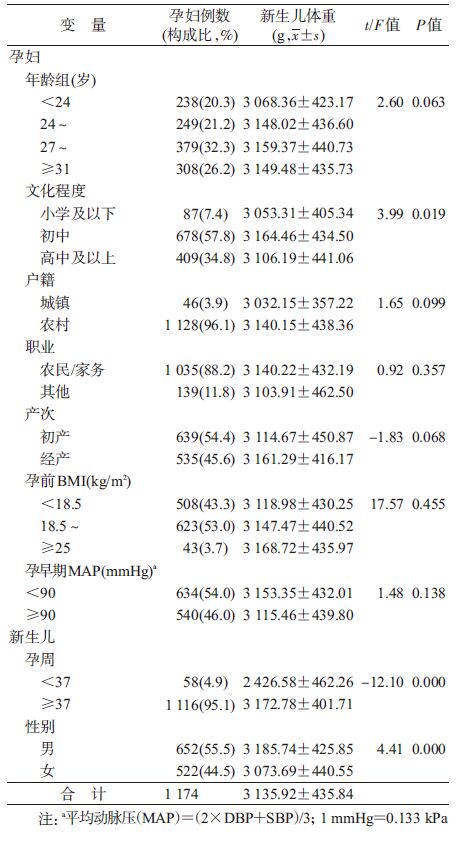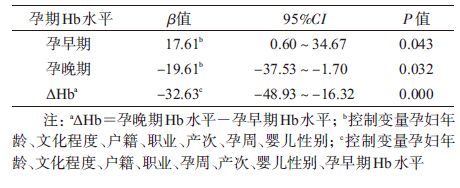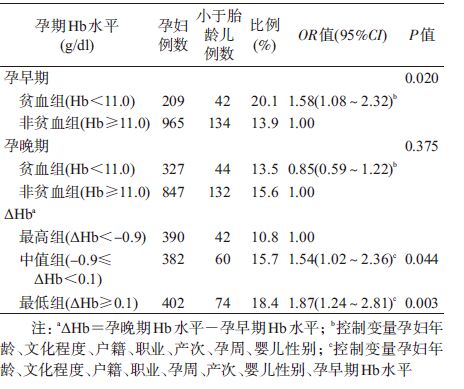文章信息
- 陈洁华, 郭雪峰, 刘顺, 龙静铧, 张国强, 黄美辰, 仇小强 .
- Chen Jiehua, Guo Xuefeng, Liu Shun, Long Jinghua, Zhang Guoqiang, Huang Meichen, Qiu Xiaoqiang .
- 广西壮族孕妇血红蛋白水平变化及其对新生儿体重影响的分析
- Impact and changes of maternal hemoglobin on birth weight in pregnant women of Zhuang Nationality, in Guangxi
- 中华流行病学杂志, 2017, 38(2): 154-157
- CHINESE JOURNAL OF EPIDEMIOLOGY, 2017, 38(2): 154-157
- http://dx.doi.org/10.3760/cma.j.issn.0254-6450.2017.02.004
-
文章历史
收稿日期: 2016-08-08
2. 531400 百色, 广西平果县妇幼保健院产科
2. Department of maternity, Pingguo County Child Health, Baise 531400, China
血红蛋白(Hb)水平监测是妊娠期检查的重要内容。近年来孕妇Hb水平变化与新生儿体重的关系引起广泛关注[1-3],但研究结论并非一致。国内外诸多研究表明孕妇Hb水平及其变化与新生儿体重的关系有一定的民族差异,如白种人孕妇低出生体重儿发生率高于加勒比地区和非洲黑种人以及巴基斯坦人和黄种人等人群[1]。国内研究也发现,拉萨地区藏族孕妇贫血发生率高于其他民族,孕妇Hb水平与新生儿体重有关联[4-5]。但广西壮族孕妇Hb水平及其变化与新生儿体重关系鲜有报道。为此,本研究调查广西壮族孕妇Hb水平及其变化与新生儿体重的关系,并探讨孕期贫血以及孕期Hb水平变化对新生儿的影响。
对象与方法1. 研究对象:采用回顾性研究方法,收集2013年5月至2015年5月在平果县医院孕检并分娩的孕妇2 386例。纳入标准:①单胎妊娠孕妇;②32~41周期间在平果县医院分娩且有孕检记录的孕妇;③直系亲属三代均为壮族的孕妇。排除标准:①患妊娠期糖尿病、地中海贫血的孕妇;②分娩异常胎儿的孕妇;③使用人工辅助生殖技术的孕妇;④双(多)胎妊娠孕妇;⑤无孕期Hb记录的孕妇。最终纳入符合标准孕妇1 174例。本研究经广西医科大学伦理委员会批准,所有研究对象严格履行知情同意。
2. 研究方法:孕妇初次产检时,由医生或护士询问基本情况和填写孕妇保健手册,妊娠期间有相应病案记录妊娠基本情况。通过孕妇保健手册,收集孕妇基本资料,通过病案记录获得孕妇孕期的基本情况以及新生儿的相关信息(分娩孕周、是否有妊娠期糖尿病、新生儿出生体重)。
3. 相关指标:采用 XE-2100型全自动血液分析仪(日本Sysemx公司)测定孕妇Hb。根据WHO标准,贫血定义为Hb<11.0 g/dl。孕早期是指妊娠开始到12周末。孕晚期是指妊娠28周至分娩结束。孕期Hb水平变化(ΔHb)计算公式:ΔHb=Hb(孕晚期)-Hb(孕早期)。使用三分位数法将孕期ΔHb分为3组:最高组为ΔHb<-0.9 g/dl;中值组为-0.9≤ΔHb(g/dl)<0.1;最低组为ΔHb≥0.1 g/dl。小于胎龄儿是指出生体重在相同胎龄平均体重的第10个百分位以下的婴儿。小于胎龄儿计算依据中国不同胎龄儿新生儿体重曲线标准[6]。
4. 统计学分析:运用SPSS 16.0软件进行统计分析。计量资料采用x±s表示,计数资料用百分数表示。利用方差分析和t检验分析人口统计学差异,采用多元线性回归方法,分析孕期Hb水平及其变化与新生儿体重的关系;用非条件logistic回归方法,分析孕期Hb贫血以及孕期Hb水平变化与小于胎龄儿发生风险的关系。P<0.05为差异有统计学意义。
结 果1. 母婴基本信息:1 174例壮族孕妇中96.1%为农村妇女,34.8%接受过高中及以上教育,54.4%为初产妇,平均年龄(27.56±4.88)岁。新生儿中55.5%为男性,44.5%为女性,平均体重(3 135.92±435.84) g(表 1)。
2. 孕期Hb水平及其变化与新生儿体重的多元线性回归分析:调整混杂因素后,结果显示孕早期Hb水平与新生儿体重呈正相关,Hb每增加1 g/dl,新生儿体重增加17.61(95%CI:0.60~34.67) g;孕晚期Hb水平与新生儿体重呈负相关,Hb每增加1 g/dl,新生儿体重减少19.61(95%CI:-37.53~-1.70) g;孕期Hb水平变化与新生儿体重呈负相关,孕期Hb每增加1 g/dl,新生儿体重减少32.63(95%CI:-48.93~-16.32) g(表 2)。
3. 孕期贫血及孕期Hb水平变化与小于胎龄儿的非条件logistic回归分析:本研究小于胎龄儿发生率为15.0%。调整混杂因素后,与孕早期非贫血组相比,贫血组小于胎龄儿发生风险增加58%(OR=1.58,95%CI:1.08~2.32);与最高组相比,中值组、最低组小于胎龄儿发生风险分别增加54%(OR=1.54,95%CI:1.02~2.36)和87%(OR=1.87,95%CI:1.24~2.81);孕晚期贫血对小于胎龄儿影响差异无统计学意义(P=0.375)。见表 3。
本研究结果显示,广西壮族妇女孕早期Hb水平与新生儿体重呈正相关,Hb每增加1 g/dl,新生儿体重增加17.61 g。但是,孕晚期Hb水平和孕期Hb变化与新生儿体重呈负相关。其中,孕晚期Hb每增加1 g/dl,新生儿体重减少19.61 g;孕期Hb每增加1 g/dl,新生儿体重减少32.63 g。Bakacak等[7]研究显示孕早期Hb水平与新生儿体重呈正相关。此外,Jwa等[2]对1 986例日本孕妇研究显示,孕晚期Hb水平与新生儿体重呈负相关,孕晚期Hb每增加1 g/dl,新生儿体重减少57.9 g,同时也发现孕期Hb水平变化与新生儿体重呈负相关,孕期Hb每增加1 g/dl,新生儿体重减少76.1 g。本研究结果与上述两项研究结果一致。
本研究还显示,孕早期贫血和孕期Hb水平下降幅度低组可增加小于胎龄儿发生风险。该结果可能与两方面原因有关。一方面,正常状态下,孕早期血浆容量尚未明显扩充,贫血可能真实地反映孕妇铁缺乏等不良营养状况,而Bakacak等[7]研究认为,孕早期贫血可直接导致胎盘组织氧流量不足,从而造成胎儿宫内发育不良。另一方面,孕期血浆容量扩充障碍,将导致血液黏稠度增高,外周循环阻力增加,子宫-胎盘的血管阻力增加,灌注量减少。这两方面的改变会引起胎盘组织缺血、缺氧,使毛细血管壁受损、脆性增高,从而导致胎儿窘迫和胎儿宫内生长受限[8]。Whittaker等[3]研究也发现孕前到孕晚期Hb浓度的变化与血容量的扩增有关,血容量扩增减少会增加小于胎龄儿发生的风险[3, 9]。妊娠期间Hb水平下降幅度减少,提示血浆容量扩充障碍,胎儿胎盘循环受损,从而引起不良的出生结局[10]。因此,孕期Hb水平下降幅度低可增加小于胎龄儿的发生风险。
本研究发现,孕晚期贫血与小于胎龄儿的发生风险无关联。这一结果可能与孕期血容量随孕期进展变化有关。因为孕期血容量的增加以血浆为主,其增长速度快于红细胞的增长速度,增加量约50%~60%,而红细胞增加量平均为450 ml,约占血容量增加总量的1/3[11]。所以,孕晚期贫血可能是血浆容量扩充与红细胞增量不相称引起的生理性贫血。因此,孕晚期贫血不增加小于胎龄儿的发生风险。
与以往研究相比,本研究增加了孕期Hb水平变化分析,以了解孕期Hb动态变化对新生儿体重的影响。但本文为回顾性研究,存在一定局限,而所有研究对象都是在平果县医院纳入,可能影响结果的代表性,今后需要进行更大样本量的前瞻性队列研究,同时增加对孕期母体血容量的分析。另外,本研究新生儿体重下降幅度较小。这可能与平果县壮族人群种族因素、身体条件、经济状况、生活环境和文化差异有关。
综上所述,本文结果表明壮族孕妇孕早期Hb水平与新生儿体重呈正相关,孕晚期Hb水平以及孕期Hb变化与新生儿体重呈负相关。孕早期贫血以及孕期Hb水平下降幅度过低是小于胎龄儿的危险因素。因此应积极治疗孕早期贫血,加强孕期Hb 水平动态监测,及时发现异常,适时处理,提高壮族孕妇和婴儿的健康。
利益冲突: 无
| [1] | Steer P, Alam M, Wadsworth J, et al. Relation between maternal haemoglobin concentration and birth weight in different ethnicgroups[J]. BMJ, 1995, 310(6978): 489–491. DOI:10.1136/bmj.310.6978.489 |
| [2] | Jwa SC, Fujiwara T, Yamanobe Y, et al. Changes in maternal hemoglobin during pregnancy and birth outcomes[J]. BMC Pregnancy Childb, 2015, 15(1): 80. DOI:10.1186/s12884-015-0516-1 |
| [3] | Whittaker PG, Macphail S, Lind T. Serial hematologic changes and pregnancy outcome[J]. Obstet Gynecol, 1996, 88(1): 33–39. DOI:10.1016/0029-7844(96)00095-6 |
| [4] |
邢远, 颜虹, 党少农, 等.
拉萨地区孕期妇女血红蛋白水平研究[J]. 中华流行病学杂志, 2008, 29(7): 668–671.
Xing Y, Yan H, Dang SN, et al. Levels of hemoglobin concentration and anemia during pregnancy in Lhasa[J]. Chin J Epidemiol, 2008, 29(7): 668–671. |
| [5] |
王小榕, 范玲, 德穷, 等.
高原地区孕妇血红蛋白水平与新生儿体重及妊娠结局关系研究[J]. 人民军医, 2013, 56(9): 1045–1047.
Wang XR, Fan L, De Q, et al. The relationship between maternal hemoglobin level and neonatal weight and pregnancy outcome in high altitude area[J]. People's Military Surgeon, 2013, 56(9): 1045–1047. |
| [6] |
朱丽, 张蓉, 张淑莲, 等.
中国不同胎龄新生儿出生体重曲线研制[J]. 中华儿科杂志, 2015, 53(2): 97–103.
Zhu L, Zhang R, Zhang SL, et al. Chinese neonatal birth weight curve for different gestational age[J]. Chin J Pediatr, 2015, 53(2): 97–103. DOI:10.3760/cma.j.issn.0578-1310.2015.02.007 |
| [7] | Bakacak M, Avci F, Ercan O, et al. The effect of maternal hemoglobin concentration on fetal birth weight according to trimesters[J]. J Matern Fetal Neonatal Med, 2015, 28(17): 2106–2110. DOI:10.3109/14767058.2014.979149 |
| [8] | Bresani CC, Braga MC, Felisberto DF, et al. Accuracy of erythrogram and serum ferritin for the maternal anemia diagnosis (AMA):a phase 3 diagnostic study on prediction of the therapeutic responsiveness to oral iron in pregnancy[J]. BMC Pregnancy Child, 2013, 13(1): 13. DOI:10.1186/1471-2393-13-13 |
| [9] | Salas SP, Rosso P, Espinoza R, et al. Maternal plasma volume expansion and hormonal changes in women with idiopathic fetal growth retardation[J]. Obstet Gynecol, 1993, 81(6): 1029–1033. |
| [10] | Steer PJ. Maternal hemoglobin concentration and birth weight[J]. Am J Clin Nutr, 2000, 71(Suppl 5): S1285–1287. |
| [11] | Link G, Clark KE, Lang U. Umbilical blood flow during pregnancy:evidence for decreasing placental perfusion[J]. Am J Obstet Gynecol, 2007, 196(5): 489.e1–489.e7. DOI:10.1016/j.ajog.2006.11.017 |
 2017, Vol. 38
2017, Vol. 38





